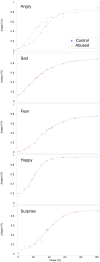Development of perceptual expertise in emotion recognition
- PMID: 19059585
- PMCID: PMC2673797
- DOI: 10.1016/j.cognition.2008.10.010
Development of perceptual expertise in emotion recognition
Abstract
How do children's early social experiences influence their perception of emotion-specific information communicated by the face? To examine this question, we tested a group of abused children who had been exposed to extremely high levels of parental anger expression and physical threat. Children were presented with arrays of stimuli that depicted the unfolding of facial expressions, from neutrality to peak emotions. The abused children accurately recognized anger early in the formation of the facial expression, when few physiological cues were available. The speed of children's recognition was associated with the degree of anger/hostility reported by the child's parent. These data highlight the ways in which perceptual learning can shape the timing of emotion perception.
Figures


Similar articles
-
Effects of early experience on children's recognition of facial displays of emotion.Dev Psychol. 2002 Sep;38(5):784-91. doi: 10.1037//0012-1649.38.5.784. Dev Psychol. 2002. PMID: 12220055
-
Perceptual learning and recognition confusion reveal the underlying relationships among the six basic emotions.Cogn Emot. 2019 Jun;33(4):754-767. doi: 10.1080/02699931.2018.1491831. Epub 2018 Jun 30. Cogn Emot. 2019. PMID: 29962270
-
Diminished facial EMG responses to disgusting scenes and happy and fearful faces in Huntington's disease.Cortex. 2018 Sep;106:185-199. doi: 10.1016/j.cortex.2018.05.019. Epub 2018 Jun 7. Cortex. 2018. PMID: 30005370
-
Age-related changes in emotion recognition across childhood: A meta-analytic review.Psychol Bull. 2024 Sep;150(9):1094-1117. doi: 10.1037/bul0000442. Psychol Bull. 2024. PMID: 39298231 Review.
-
Emotion Recognition in Adults With a History of Childhood Maltreatment: A Systematic Review.Trauma Violence Abuse. 2023 Jan;24(1):278-294. doi: 10.1177/15248380211029403. Epub 2021 Jul 9. Trauma Violence Abuse. 2023. PMID: 34238064 Free PMC article.
Cited by
-
Hidden talents in context: Cognitive performance with abstract versus ecological stimuli among adversity-exposed youth.Child Dev. 2022 Sep;93(5):1493-1510. doi: 10.1111/cdev.13766. Epub 2022 Apr 11. Child Dev. 2022. PMID: 35404500 Free PMC article.
-
Probabilistic learning of emotion categories.J Exp Psychol Gen. 2019 Oct;148(10):1814-1827. doi: 10.1037/xge0000529. Epub 2018 Dec 20. J Exp Psychol Gen. 2019. PMID: 30570327 Free PMC article.
-
Relationship Between the Self-Concept of Children and Their Ability to Recognize Emotions in Others.Front Psychol. 2021 Oct 12;12:672919. doi: 10.3389/fpsyg.2021.672919. eCollection 2021. Front Psychol. 2021. PMID: 34712163 Free PMC article.
-
Unsupervised learning of facial emotion decoding skills.Front Hum Neurosci. 2014 Feb 27;8:77. doi: 10.3389/fnhum.2014.00077. eCollection 2014. Front Hum Neurosci. 2014. PMID: 24578686 Free PMC article.
-
Impact of the War in Ukraine on the Ability of Children to Recognize Basic Emotions.Int J Public Health. 2024 May 13;69:1607094. doi: 10.3389/ijph.2024.1607094. eCollection 2024. Int J Public Health. 2024. PMID: 38835807 Free PMC article.
References
-
- Bornstein MH, Arterberry ME. Recognition, discrimination and categorization of smiling by 5-month-old infants. Developmental Science. 2003;6:585–599.
-
- Carey S, Diamond R. Are faces perceived as configurations more by adults than by children? Visual Cognition. 1994;1:253–174.
-
- Diamond R, Carey S. Why faces are and are not special: An effect of expertise. Journal of Experimental Psychology: General. 1986;115:107–117. - PubMed
-
- Dolan RJ, Fink GR, Rolls E, Booth M, Holmes A, Frackowiak RSJ, Friston KJ. How the brain learns to see objects and faces in an impoverished context. Nature. 1997;389:596–599. - PubMed
-
- Ekman P. The directed facial action technique. In: Coan JA, Allen JB, editors. The handbook of emotion elicitation and assessment, Oxford University Press Series in Affective Science. New York, NY: Oxford University; In press.
MeSH terms
Grants and funding
LinkOut - more resources
Full Text Sources

